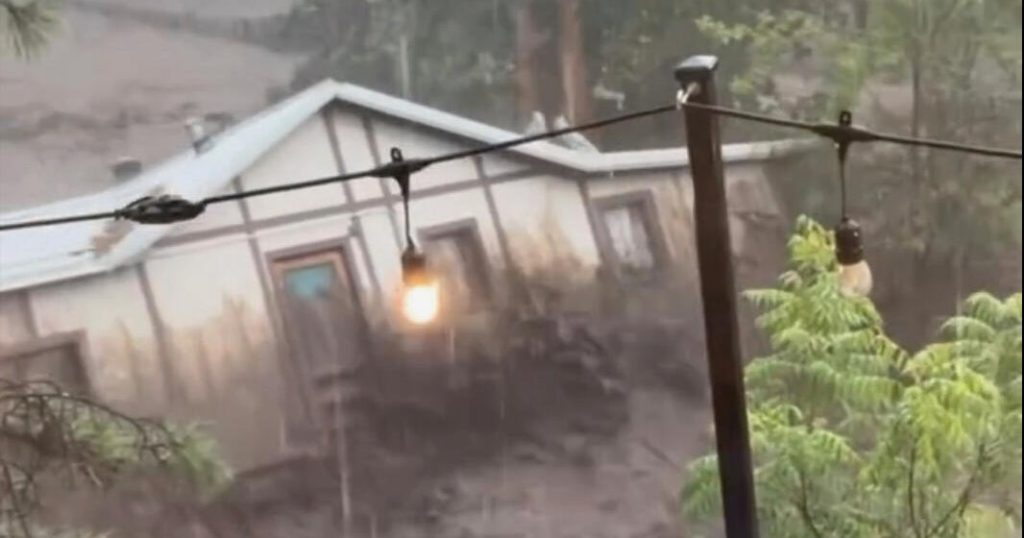Flash flooding in the Ruidoso area of southern New Mexico claimed the lives of at least three individuals and led to numerous rescues as torrential rains wreaked havoc on the region. This incident unfolded on Tuesday, in the same area that suffered extensive damage from wildfires last summer. Eyewitness accounts and reports from officials reveal severe flooding conditions, overwhelming first responders and prompting emergency declarations for federal assistance.
| Article Subheadings |
|---|
| 1) The Catastrophic Flooding Events |
| 2) Local and Federal Emergency Responses |
| 3) The Impact on Infrastructure and Homes |
| 4) Previous Disasters and Current Risks |
| 5) The Community’s Resilience and Response |
The Catastrophic Flooding Events
On Tuesday, torrential rains fell on the Ruidoso region, resulting in extreme flash flooding that overwhelmed the local waterways. Reports indicate that multiple residents were swept away as the rising waters surged through the area. Tragically, officials later confirmed the discovery of three bodies—a four-year-old girl, a seven-year-old boy, and a man aged between 40 to 50—who had been swept downstream. Rescues unfolded swiftly, with local authorities conducting between 50 to 60 swift water rescues to bring trapped individuals to safety. Eyewitnesses described scenes of chaos as homes were lifted and carried away by the rapid flow of the Rio Ruidoso, exemplifying the sheer force of nature unleashed in those critical hours.
Local and Federal Emergency Responses
In light of the devastating flooding, New Mexico Governor Michelle Lujan Grisham declared a state of emergency, stressing the urgent need for federal assistance. In a statement, she expressed hope that additional resources would arrive promptly. “We’ve watched Texas receive federal resources they desperately needed, and Ruidoso deserves that same urgent response,” she noted. The state’s emergency teams have been engaged in ongoing rescue missions while simultaneously assessing the damage and preparing for further interventions. The swift actions taken by local authorities, aided by support from the state, highlight a collaborative effort to manage and mitigate the fallout from this climatic disaster.
The Impact on Infrastructure and Homes
The flooding has left a significant imprint on the infrastructure of the Ruidoso area. With several homes completely destroyed or severely flood-damaged, the implications of this natural disaster are profound. Roads were inundated and debris scattered widely, complicating rescue operations and initial recovery efforts. Officials reported that approximately a dozen roads were closed due to hazardous conditions. As community members begin to assess the damage, the focus is shifting toward recovery and rebuilding, with many residents grappling with the heavy emotional toll of the loss.
Previous Disasters and Current Risks
This catastrophic flooding comes on the heels of previous disasters in the Ruidoso area, particularly the wildfires that charred much of Lincoln County just last summer. These fires not only caused immense property damage but also altered the landscape, leaving damaged soil that is more vulnerable to erosion and flooding. The scars left by the wildfires significantly heighten the risk of flash floods in the region, creating a dangerous cycle of disaster. Studies indicate that areas affected by wildfires can experience increased flood risks for several years, emphasizing the need for comprehensive disaster preparedness and response strategies in fire-scarred communities like Ruidoso.
The Community’s Resilience and Response
Despite the overwhelming challenges posed by the flooding, the spirit of resilience within the Ruidoso community has been commendable. Residents have come together to support one another, providing shelter and assistance to those affected by the flooding. Videos shared on social media illustrated the community’s quick thinking, with citizens rallying to help friends and neighbors escape flooded homes and vehicles. Local businesses, like the Downshift Brewing Company, have opened their doors to provide refuge to those seeking shelter from the storm. As recovery efforts unfold, the emphasis remains on collaboration among community members, local responders, and state officials, ensuring that the rebuilding process is a collective effort.
| No. | Key Points |
|---|---|
| 1 | Flash flooding in Ruidoso, NM resulted in three fatalities and numerous rescues. |
| 2 | Governor Michelle Lujan Grisham declared a state of emergency and requested federal assistance. |
| 3 | The flooding has severely impacted the area’s infrastructure, closing numerous roads and damaging homes. |
| 4 | Recent wildfires have exacerbated the flooding risks, making the region more vulnerable. |
| 5 | The Ruidoso community is demonstrating resilience and unity in the face of this disaster. |
Summary
The tragic flash flooding in Ruidoso, New Mexico, serves as a stark reminder of the destructive power of extreme weather events, especially in areas with prior damage from wildfires. The loss of life and significant impact on community infrastructure necessitate immediate and long-term recovery efforts. As local leaders work to address the pressing needs of residents, the spirit of community resilience shimmers through, creating hope amid the devastation. This incident underscores the importance of preparedness in flood-prone regions, advocating for necessary adaptations in policy and infrastructure to ensure better safeguarding against future disasters.
Frequently Asked Questions
Question: What caused the flooding in Ruidoso?
The flooding was triggered by torrential rain that led to the rapid rise of the Rio Ruidoso beyond its capacity, overwhelming the area.
Question: How did the local government respond to the flooding?
Local government officials, along with the governor, declared a state of emergency to facilitate a coordinated response and secure federal assistance for recovery efforts.
Question: What is the relationship between wildfires and flooding risks?
Wildfires can destabilize soil, increasing the likelihood of flooding as vegetation that normally retains soil and water is lost, creating conditions ripe for runoff and erosion during heavy rains.


